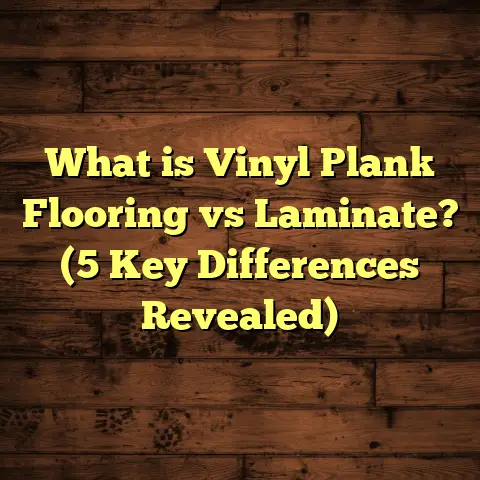What is 3 Strip Laminate Flooring? (5 Key Benefits Exposed!)
Keeping things simple is my favorite way to talk about flooring. When I first got into the business, I realized how overwhelming all the flooring choices could be for anyone. So, I always try to break it down and explain things like I’m chatting with a friend over coffee. Today, I want to share what I know about one specific type of laminate flooring that has caught my attention: 3 strip laminate flooring. If you’ve heard the term but aren’t sure what it really means or why people love it, stick with me—I’ll walk you through it.
What is 3 Strip Laminate Flooring?
So, what exactly is 3 strip laminate flooring? Simply put, it’s a style of laminate flooring where each plank features three distinct strips of wood grain or design running lengthwise. Unlike traditional laminate planks that have a single continuous pattern, these three strips are narrower and arranged side by side on the plank.
This style mimics the look of classic hardwood floors made from three narrow strips of wood glued together, often called engineered hardwood with three-strip design. The laminate version copies this aesthetic but uses a high-resolution photographic layer to give the appearance of real wood grain. Underneath, there’s a core layer made usually from high-density fiberboard (HDF), which gives durability and stability.
I’ve installed quite a few of these in homes, and the look always gets compliments. It’s like getting the warmth and character of hardwood but at a fraction of the cost and maintenance hassle.
Why does this matter?
Well, 3 strip laminate floors bring a mix of style and practicality that’s often missing in other flooring options. They offer a textured, natural look that doesn’t feel mass-produced. And because each plank’s pattern breaks up the floor visually, it can make your space feel more dynamic and interesting.
My Experience With 3 Strip Laminate Flooring
I remember helping a client, Lisa, who was hesitant about laminate because she’d had bad experiences with cheap, flat-looking floors before. She wanted something that felt “real” but didn’t break the bank. When I showed her samples of 3 strip laminate, she loved how natural and inviting it looked.
We chose a medium oak tone with subtle grain variations. Once installed, the floor’s three-strip design added depth and charm to her living room without the heavy price tag of hardwood. She told me later that her friends kept asking if it was real wood! That’s the kind of reaction I like to see.
Another time, I worked on a renovation for a young couple who wanted something both stylish and kid-proof. They’d looked at solid hardwood but were worried about scratches from their toddlers’ toys. I suggested 3 strip laminate because it had that same classic wood look but was much tougher against dents and spills. The floor has held up beautifully for over three years now.
5 Key Benefits of 3 Strip Laminate Flooring
Let’s talk benefits because, honestly, that’s what everyone cares about.
1. Looks Like Real Hardwood Without the Price
One of the biggest draws is how closely this style mimics real hardwood floors. The three-strip design adds authenticity because traditional hardwood floors often have multiple narrow strips glued side by side for strength and design.
According to industry data, laminate flooring can cost 30% to 50% less than comparable hardwood options. That means you can get that classic look without stretching your budget too far.
But here’s an interesting fact: some 3 strip laminate floors now feature embossed textures that feel just like real wood grain under your feet. This wasn’t common a few years ago but has become a game-changer in mimicking hardwood’s tactile feel.
2. Durability That Handles Everyday Life
Laminate floors are known for their toughness, but 3 strip laminate is especially resilient because of its layered structure.
The top wear layer protects against scratches, dents, and stains — great if you have kids or pets. In fact, some brands offer wear layers rated up to AC4 or AC5 (abrasion classes), meaning they can withstand heavy foot traffic in homes or light commercial use.
In my projects, I’ve seen floors installed over five years ago still holding up beautifully in busy kitchens and hallways with this rating.
What’s more, some manufacturers now include advanced water-resistant coatings on their laminates which help prevent damage from spills or minor moisture exposure. This makes 3 strip laminate an even better choice for kitchens or mudrooms.
3. Installation Is User-Friendly
I like how straightforward these floors are to install. The planks usually have a click-lock system, meaning they snap together without nails or glue.
Because each plank is wider than traditional hardwood strips but has multiple narrow strips printed on it, installation looks precise without being fiddly.
Here’s a quick story: I once helped a DIY homeowner who was nervous about laying flooring themselves. With 3 strip laminate, they found it manageable and were thrilled with the final look.
I also appreciate that these floors can be installed over many existing surfaces — like concrete slabs with proper moisture barriers or over old vinyl — making renovations faster and less disruptive.
4. Low Maintenance for Busy Lives
If you ask me what flooring type fits busy households best, this would be high on my list.
You just sweep or vacuum regularly and mop occasionally with a damp cloth—no need for sanding or refinishing like hardwood demands.
Plus, since it’s resistant to fading and moisture (to some extent), it stays looking fresh for years.
In homes where I’ve installed this flooring five-plus years ago, clients report very little wear visible on the surface despite daily foot traffic from kids and pets.
5. Adds Value and Style to Your Home
While hardwood floors are often seen as a home value booster, 3 strip laminate flooring can also improve your home’s appeal at resale time.
According to a survey by the National Association of Realtors, flooring ranks among the top three upgrades homeowners want when buying or selling homes.
The unique look of 3 strip laminate helps your space stand out while appealing to buyers who want style without maintenance headaches.
A Closer Look: How Does 3 Strip Laminate Stack Up?
I wanted to dig deeper into how this flooring performs compared to other popular options like solid hardwood or vinyl plank. So I reviewed some specs and case studies from trusted flooring manufacturers.
| Feature | 3 Strip Laminate Flooring | Solid Hardwood | Vinyl Plank Flooring |
|---|---|---|---|
| Average Cost per Sq Ft | $2 – $5 | $5 – $10 | $2 – $7 |
| Installation Difficulty | Moderate (DIY possible) | Difficult (professional needed) | Easy (DIY friendly) |
| Durability Rating | AC3 – AC5 | Moderate (prone to dents/scratches) | High (waterproof options available) |
| Maintenance | Low | High (requires refinishing) | Low |
| Appearance | Very close to hardwood | Authentic wood | Varies (can look synthetic) |
Looking at these numbers, the value proposition for 3 strip laminate becomes clear: You get close-to-wood looks at a reasonable price with manageable upkeep.
How I Use FloorTally for Cost Estimation
Whenever I start planning a flooring project—whether for myself or clients—I rely on tools like FloorTally to get accurate cost estimates quickly.
It’s super helpful because it factors in:
- Local material prices (which vary widely by region)
- Labor costs based on project size and complexity
- Waste factor (extra materials needed to cover cuts/waste)
For example, last year I helped a family figure out the budget for installing 3 strip laminate throughout their living areas totaling around 800 sq ft. FloorTally gave us a detailed breakdown including installation labor and materials with waste allowance included.
This saved me from bouncing between multiple suppliers and contractors trying to piece together numbers manually. It makes budgeting more realistic and less stressful.
Plus, having a clear, itemized cost estimate upfront helps clients feel confident about their investment—it removes surprises later on.
Understanding the Design Appeal of 3 Strip Laminate Flooring
One of the reasons I keep recommending 3 strip laminate is its design versatility.
The three-strip layout isn’t just a random pattern; it comes from traditional European hardwood flooring techniques where narrow strips of wood were glued side by side to form wider planks. This created stronger boards less prone to warping.
When translated into laminate form, this pattern gives your floor subtle variety in color and grain across each plank without overwhelming the eye.
If you like floors that look natural but not uniform, this style is perfect. It breaks up large areas visually and adds character you don’t always get with single-strip laminates.
Breaking Down the Structure: What Makes 3 Strip Laminate Durable?
Let me explain how these planks are built because their composition plays a big role in their performance.
- Wear Layer
This is the top transparent layer protecting your floor from scratches, scuffs, stains, and fading from sunlight. Higher quality laminates have thicker wear layers rated AC4 or AC5 (AC means abrasion class). - Decorative Layer
Right below the wear layer is a high-resolution photographic image that mimics wood grain patterns—this is where the three strips come alive visually. - Core Layer
Usually made from HDF (high-density fiberboard), this middle layer gives strength and stability. It also resists moisture better than regular MDF or particleboard—key if you’re worried about kitchen or hallway spills. - Backing Layer
The bottom stabilizes the plank against moisture from underneath and prevents warping or swelling over time.
When these layers work together well—as they do in quality 3 strip laminates—you get floors that are tough but still comfortable underfoot.
Who Should Consider 3 Strip Laminate Flooring?
Thinking about whether this is right for you? Here are some scenarios where I often recommend it:
- Families with kids or pets: The durability and scratch resistance mean fewer worries about damage.
- Budget-conscious homeowners: Lower upfront costs than hardwood but similar looks.
- DIY enthusiasts: Easier installation saves on labor bills.
- Apartment dwellers: Many buildings restrict hardwood due to noise; laminate offers quieter walking with proper underlayment.
- Renovators needing fast updates: Can be installed over existing subfloors quickly without major prep.
- Anyone wanting classic style with easy care: The subtle three-strip design fits many decor styles—from rustic farmhouse to modern minimalism.
Comparing with Other Popular Flooring Options
To help you decide if 3 strip laminate fits your needs, here’s how it stacks up against other common choices:
Solid Hardwood Floors
Hardwood has undeniable charm but comes with higher costs ($5-$10 per sq ft) and ongoing maintenance like sanding/refinishing every few years. Hardwood is also more sensitive to moisture changes which can cause gaps or warping.
If you want authentic wood grain and don’t mind upkeep or budget, hardwood is great—but for many homeowners wanting less fuss with similar looks, 3 strip laminate is an excellent alternative.
Vinyl Plank Flooring
Vinyl plank flooring has surged in popularity due to waterproof qualities and affordability ($2-$7 per sq ft).
While vinyl can mimic wood grain too, many find its texture less convincing than laminate’s embossed surfaces. Also, vinyl tends to feel softer underfoot but sometimes less “solid.”
Choosing between vinyl and 3 strip laminate often comes down to whether you prioritize moisture resistance over texture authenticity.
Traditional Laminate (Single Strip)
Regular laminate usually features planks with one continuous wood grain pattern rather than multiple strips across each plank. The single-strip look can sometimes feel repetitive or less natural.
That’s why I’m partial to 3 strip laminate—it breaks visual monotony nicely and brings more warmth to rooms.
Installation Tips Based on My Work
If you’re thinking about installing 3 strip laminate yourself or supervising contractors, here are some pointers I’ve learned over years:
- Acclimate your flooring: Let unopened cartons sit in your home environment for at least 48 hours before installation so materials adjust to temperature/humidity.
- Prepare subfloor: It should be clean, dry, level within 3/16 inch over 10 feet to avoid uneven planks.
- Use proper underlayment: This adds sound insulation and moisture barrier qualities.
- Leave expansion gaps: Because these floors expand/contract slightly with temperature changes, leave around 1/4 inch gap at walls.
- Stagger seams: Arrange planks so seams don’t line up in adjacent rows—this adds strength and visual appeal.
- Use spacers: Keep spacers between planks and walls during installation for consistent gaps.
- Clean as you go: Remove dust/debris regularly so joints fit snugly without gaps.
Installing this type of laminate isn’t rocket science but attention to detail makes all the difference between good and great results.
Maintenance Tips That Help Floors Last Longer
Keeping your floor looking fresh doesn’t require much effort but some habits help:
- Sweep/vacuum frequently to remove dirt/grit that causes scratches.
- Use felt pads on furniture legs—trust me on this one; moving tables without pads creates marks fast.
- Wipe spills immediately—water left standing can damage edges.
- Avoid steam mops; excessive moisture can seep into seams.
- Use rugs at entrances to reduce tracked-in dirt.
- Periodically check for loose planks or edges lifting—catching small problems early prevents bigger repairs later.
Real Case Study: A Family Kitchen Renovation
To give you an idea of real-world performance, here’s a story from one of my recent jobs:
The Martins wanted to update their kitchen floor but had two young kids who loved playing on the floor plus a dog that often came indoors wet after walks.
They chose a dark walnut-tone 3 strip laminate with AC5 wear rating plus water-resistant coating. Installation took two days over their existing vinyl tile after minor leveling work.
After six months, they reported:
- No visible scratches despite heavy traffic
- Easy cleanup after spills
- Warm feel compared to tile
- Compliments from guests about how natural it looked
This project confirmed for me how well-suited 3 strip laminate can be for active family spaces needing both style and resilience.
Environmental Considerations
If you care about sustainability (I do), it’s worth noting:
- Many manufacturers now produce laminate using recycled wood fibers for cores.
- Some use low-VOC adhesives reducing indoor air pollution.
- Laminate floors tend to last long without needing replacement—reducing waste.
While not as eco-friendly as solid wood harvested responsibly or cork flooring options, choosing quality laminate with greener certifications helps reduce environmental impact compared to cheap imports.
What About Color & Finish Options?
You’re not stuck with just oak or maple tones here—the market offers wide choices:
- Light bleached woods for airy modern spaces
- Rich dark browns for cozy traditional looks
- Gray-washed planks trending in urban loft designs
- Matte finishes that reduce glare
- Slightly textured surfaces giving natural grip
This variety means you can tailor your floor exactly to your style preferences without sacrificing durability or budget constraints.
How Long Will Your Investment Last?
Based on my experience and manufacturer warranties:
- Average lifespan ranges from 10 to 20 years depending on wear layer quality and care.
- High-end products with thicker wear layers last longer under heavy use.
- Resurfacing isn’t an option like hardwood; when worn out, replacement is necessary.
Still, when balanced against price savings versus hardwood replacement costs every decade or so—and factoring in ease of maintenance—the value is clear.
Can You Refinish or Repair 3 Strip Laminate Flooring?
One common question I get: “If my floor gets damaged can I refinish it?”
Unlike hardwood that can be sanded down multiple times, laminate floors do not refinish well because their decorative photographic layer is thin—once damaged, you generally replace individual planks if possible.
Good news though: because installation uses click-lock systems, replacing damaged boards is usually straightforward without tearing up large areas.
Is It Noisy? What About Comfort?
Laminate floors sometimes get criticized for feeling “hard” or sounding hollow when walked on barefoot.
You can minimize this by:
- Installing quality underlayment designed for sound absorption
- Using area rugs in seating areas
- Choosing laminates with thicker cores which provide more cushioning
In my projects where these steps were followed, clients say they barely notice any difference compared to hardwood in terms of comfort or noise levels.
How Does Climate Affect 3 Strip Laminate Flooring?
Another point worth mentioning: if you live somewhere with wide temperature/humidity swings (like colder northern states), laminate floors may expand or contract slightly leading to small gaps or buckling if not properly installed with expansion room.
Using acclimation periods before installation plus maintaining steady indoor humidity levels helps prevent most issues.
Can You Use Radiant Heat Underneath?
Yes! Many modern laminates including 3 strip styles are compatible with radiant heating systems installed beneath subfloors—great if you want cozy warm floors in colder months.
Just check manufacturer specs because some products have limits on maximum heat output or require special installation methods with heating mats.
Final Thoughts
If you want flooring that balances style, durability, ease of installation, and budget-friendliness, 3 strip laminate flooring deserves serious thought. It’s one of those options that feels like a smart compromise—getting many benefits of hardwood without many drawbacks.
When I recommend this to friends or clients, they often come back happy months later because their floor looks great and stands up well to daily life.
Have you ever tried 3 strip laminate flooring or thinking about it? What’s holding you back? Feel free to ask—I’m here to help!





